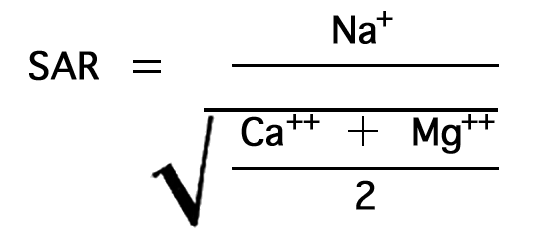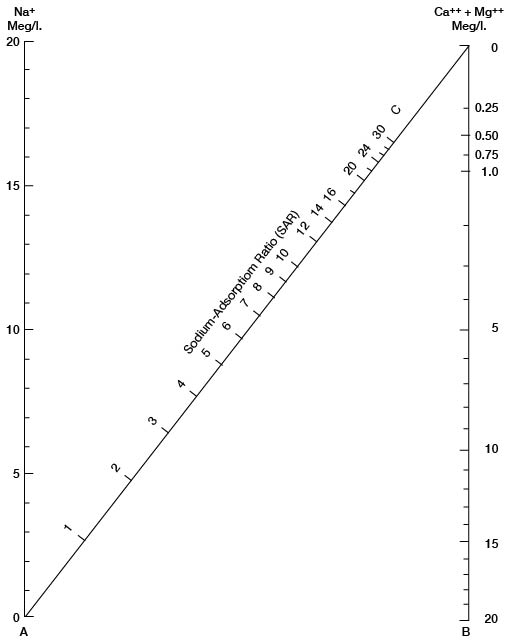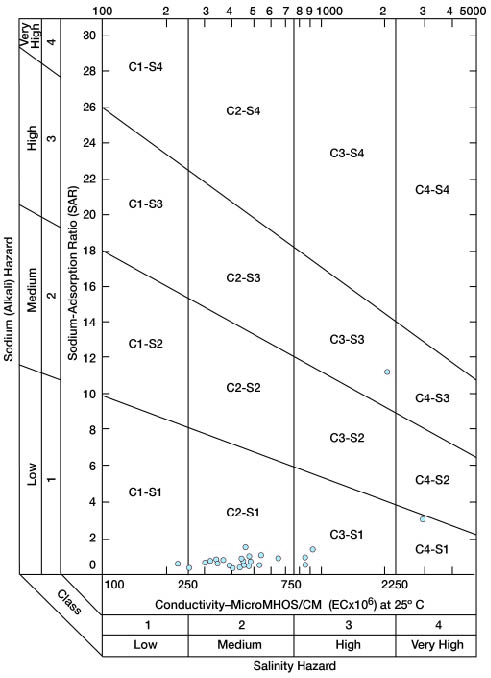Prev Page--Recharge, Discharge, and Utilization || Next Page--Formations
Ground Water, continued
Chemical Character of Ground Water
The chemical character of the water in Kingman County is indicated by analyses of 25 samples of water collected from 21 wells, 2 springs, and 2 rivers. The results of the analyses are given in Table 4. The analyses were made by Howard A. Stoltenberg, Chemist, in the Water and Sewage Laboratory of the Kansas State Board of Health. In general, the analyses do not indicate the sanitary condition of the water.
Chemical Constituents in Relation to Use
Dissolved solids--When water is evaporated the residue consists mainly of the mineral constituents given in the table of analyses (Table 4). In addition to the mineral constituents, the residue generally includes small quantities of organic matter and a small amount of water of crystallization. Water containing less than 500 ppm (parts per million) of dissolved solids is suitable for domestic use, except for difficulties resulting from hardness or the presence of iron in excessive amounts. Water containing more than 1,000 ppm of dissolved solids is likely to contain enough of certain constituents to cause noticeable taste or otherwise make the water undesirable or unsuitable for use. The dissolved solids in 25 water samples collected in Kingman County ranged from 152 to 1,920 ppm; 22 of these samples contained between 152 and 497 ppm, one contained 604 ppm, and two samples contained more than 1,000 ppm. One of the samples (28-6-25bbc) high in dissolved solids was a surface-water sample from South Fork of Ninnescah River. The river water has a high concentration of dissolved solids during low flow because of natural inflow of salt water.
Hardness--The hardness of water is most commonly recognized by its effect when soap is used with the water. Salts of calcium and magnesium cause nearly all the hardness of ordinary water. These constituents also are the active agents in the formation of scale in steam boilers and the other containers in which water is heated or evaporated.
The total hardness, carbonate hardness, and noncarbonate hardness of the water samples from Kingman County are given in Table 4. The carbonate hardness, or "temporary hardness"', is caused by calcium and magnesium bicarbonates and can be almost entirely removed by boiling the water. The noncarbonate hardness, or "permanent hardness", is caused by sulfates and chlorides of calcium and magnesium and other salts and cannot be removed by boiling. Carbonate hardness and noncarbonate hardness react in the same manner in the relation to the use of soap. When used in boilers, water having noncarbonate hardness forms a harder scale than water having only carbonate hardness.
Water having a hardness of less than 50 ppm is classified as soft, and treatment for reduction of hardness is not necessary for ordinary uses. Hardness between 50 and 150 ppm does not seriously interfere with the use of water for most purposes, but does increase the consumption of soap. Laundries and other industries using large quantities of soap, or to which hardness is objectionable in other ways, may profitably soften such water. Water of this range of hardness will form scale in steam boilers and generally is softened before being used. Hardness of more than 150 ppm is noticeable by almost everyone.
The hardness of water samples collected in Kingman County ranged from 84 to 1,010 ppm. Eight of the samples had a hardness of less than 150 ppm, ten a hardness between 151 and 200 ppm, six a hardness between 201 and 400 ppm, and one a hardness of more than 1,000 ppm.
Iron--Next to hardness, iron is the constituent in natural waters that generally is the most objectionable. The quantity of iron in water may differ greatly from place to place, even in the same aquifer. If the water contains more than 0.3 ppm of iron in solution, the iron upon oxidation may settle out as a reddish sediment. Iron, if present in sufficient quantity, gives a disagreeable taste to water, stains clothing, cooking utensils, and plumbing fixtures, and is objectionable in the preparation of foods and beverages. Iron generally can be removed by aeration and filtration, but some waters require chemical treatment for removal of iron.
The iron content of water samples collected in Kingman County ranged from 0.03 to 2.9 ppm. Sixteen of the samples contained 0.3 ppm or less and nine contained more than 0.3 ppm.
Manganese has similar properties except that the stain is black. Iron and manganese are considered together in evaluating the usefulness of water.
Chloride--Chloride salts are very abundant in nature. They are found in quantity in sea water and oil-field brines and are dissolved in small quantities from many rock materials. Chloride has little effect on the suitability of water for ordinary use unless present in such concentration as to make the water unpotable or corrosive. The removal of chloride from water is difficult and too costly for most water uses.
The chloride content of water samples collected in Kingman County ranged from 8 to 575 ppm. The chloride content was highest, 575 ppm, in water from South Fork of Ninnescah River. Of the 23 ground-water samples analyzed only one (30-5-35cbb) had a chloride concentration greater than 100 ppm. All other samples bad chloride concentrations of 50 ppm or less.
Fluoride--Fluoride is present in ground water only in small quantities, but a knowledge of the fluoride content of water is important because the use of water containing fluoride in excess of 1.5 ppm by children during the formation of permanent teeth may cause mottling of the tooth enamel. If the fluoride content is as much as 4 ppm, about 90 percent of the children using the water may have mottled tooth enamel (Dean, 1936). Although too much fluoride has a detrimental effect, investigations indicate that a fluoride concentration of about 1 ppm in drinking water lessens the incidence of tooth decay (Dean and others, 1941). The fluoride concentration in samples of water collected in Kingman County ranged from 0.1 to 0.6 ppm.
Nitrate--Investigations in the last two decades on the effect of nitrate in drinking water have shown that large concentrations of nitrate in water may cause cyanosis in infants (blue babies) when the water is used for drinking and in the preparation of formulas for feeding. Infant cyanosis is usually not fatal if diagnosed in time but may be fatal with continued use of water containing excessive nitrate. Water that contains more than 90 ppm of nitrate is regarded by the Kansas State Board of Health as likely to cause infant cyanosis (Metzler and Stoltenberg, 1950). Moderate nitrate concentrations are seemingly not harmful to older children or adults. Nitrate cannot be removed from water by boiling. The nitrate concentration in samples of water collected in Kingman County ranged from 1.8 to 111 ppm. Of the 25 samples, 24 had a nitrate concentration of 42 ppm or less and only 1 sample (28-6-12cdd), having a nitrate concentration of 111 ppm, would be regarded as unsafe for feeding to infants.
Chemical Constituents in Relation to Irrigation
The following discussion of the suitability of water for irrigation use is adapted from Agriculture Handbook 60 of the U. S. Department of Agriculture (U. S. Salinity Laboratory Staff, 1954).
The development and maintenance of successful irrigation projects involve not only supplying irrigation water to the land but also control of salt and alkali in the soil. The quality of irrigation water, irrigation practices, and drainage conditions are involved in salinity and alkali control. Soil that was originally nonsaline and nonalkali may become unproductive if excessive soluble salts or exchangeable sodium are allowed to accumulate because of improper irrigation and soil-management practices or inadequate drainage.
In areas of sufficient rainfall and ideal soil conditions the soluble salts originally present in the soil or added to the soil with water are carried downward by the water and ultimately reach the water table. The process of solution and transportation of soluble salts by water moving through the soil is called leaching. If the amount of water applied to the soil is not in excess of the amount needed by plants, there will be no downward percolation of water below the root zone and mineral matter will accumulate at that point. Impermeable soil zones near the surface can retard the downward movement of water, resulting in waterlogging of the soil and deposition of salts. Unless drainage is adequate, attempts at leaching may not be successful, because leaching requires the free passage of water through and away from the root zone.
The characteristics of water for irrigation that seem to be most important in determining its quality are: (1) total concentration of soluble salts; (2) relative proportion of sodium to other principal cations (magnesium, calcium, and potassium), (3) concentration of boron or other elements that may be toxic to plants; and (4) under some conditions, the bicarbonate concentration as related to the concentration of calcium plus magnesium.
The total concentration of soluble salts in irrigation water can be adequately expressed in terms of electrical conductivity for purposes of diagnosis and classification. Electrical conductivity is a measure of the ability of the ionized inorganic salts in solution to conduct an electrical current, and is usually expressed in terms of micromhos per centimeter at 25°C. The electrical conductivity can be determined accurately in the laboratory, or an approximation of the electrical conductivity can be obtained by multiplying the total equivalents per million (epm) of calcium, magnesium, sodium, and potassium by 100, or by dividing the dissolved solids in parts per million by a factor of 0.6 to 0.7 (Table 5). In general, water having an electrical conductivity below 750 micromhos per centimeter is satisfactory for irrigation insofar as salt content is concerned, although salt-sensitive crops may be adversely affected by irrigation water having an electrical conductivity in the range of 250 to 750 micromhos per centimeter. Water in the range of 750 to 2,250 micromhos per centimeter is widely used, and satisfactory crop growth is obtained under good management and favorable drainage conditions, but saline conditions will develop if leaching and drainage are inadequate. Use of water having a conductivity of more than 2,250 micromhos per centimeter is not common, and very few places can be cited where such waters have been used successfully.
Table 5--Factors for converting parts per million of mineral constituents to equivalents per million.
| Cation | Conversion factor | Anion | Conversion factor |
|---|---|---|---|
| Ca++ | 0.0499 | HCO3- | 0.0164 |
| Mg++ | 0.0822 | SO4-- | 0.0208 |
| Na+ | 0.0435 | Cl- | 0.0282 |
| NO3- | 0.0161 | ||
| F- | 0.0526 |
In the past, the relative proportion of sodium to other cations in irrigation water usually has been expressed simply as the percentage of sodium among the principal cations (expressed in equivalents)--the percent sodium, so called. According to the U. S. Department of Agriculture the sodium-adsorption ratio (SAR), used to express the relative activity of sodium ions in exchange reactions with soil, is a better measure of suitability of water for irrigation with respect to the sodium (alkali) hazard. The sodium-adsorption ratio may be determined by the formula

where the ionic concentrations are expressed in equivalents per million. The sodium-adsorption ratio may be determined also by use of the nomogram shown in Figure 12. In using the nomogram to determine the sodium-adsorption ratio of water, the concentration of sodium expressed in equivalents per million is plotted on the left-hand scale, and the concentration of calcium plus magnesium expressed in equivalents per million is plotted on the right-hand scale. The point at which a line connecting these two points intersects the scale for sodium-adsorption ratio indicates the sodium-adsorption ratio of the water.
Figure 12--Nomogram used to determine sodium-adsorption ratio of water.

When the sodium-adsorption ratio and the electrical conductivity of a water are known, the classification of the water for irrigation can be determined by plotting these values on the diagram shown in Figure 13. Table 6 gives the sodium-adsorption ratio and approximate electrical conductivity of water samples that are plotted on Figure 13 and for which analyses are given in Table 4. Low-sodium water (S1) can be used for irrigation on almost all soils with little danger of developing harmful levels of exchangeable sodium. Medium-sodium water (S2) will present an appreciable sodium hazard in certain fine-textured soils, especially poorly leached ones. Such water may be used safely on coarse-textured or organic soils having good permeability. High-sodium water (S3) may produce harmful levels of exchangeable sodium in most soils and will require special soil management such as good drainage and leaching and addition of organic matter. Very high sodium water (S4) is generally unsatisfactory for irrigation unless special action is taken, such as addition of gypsum to the soil.
Figure 13--Diagram showing suitability of water for irrigation.

Table 6--Sodium-adsorption ratio (SAR) and approximate conductivity of water samples that are plotted on Figure 13 and for which analyses are given in Table 4.
| Well number | Sodium- adsorption ratio |
Conductivity (micromhos) 100 x (Ca + Mg + Na) |
|---|---|---|
| 27-5-3ccc | 0.8 | 330 |
| 27-5-36aab | .6 | 535 |
| 27-6-6ccd | 1.4 | 920 |
| 27-7-3adc | .9 | 660 |
| 27-8-15ddb | .7 | 490 |
| 27-8-31cca | 1.5 | 455 |
| 27-9-18dcc | .4 | 430 |
| 27-10-32dcc1 | .4 | 445 |
| 28-6-12cdd | .6 | 865 |
| 28-6-25bbc | 11.1 | 2,070 |
| 28-7-30ddd | .6 | 225 |
| 28-8-2ccc | .7 | 320 |
| 28-10-5dbb | .4 | 400 |
| 29-7-9baa | .9 | 470 |
| 29-7-10abb | .4 | 305 |
| 29-7-24dba | .9 | 450 |
| 29-7-26abb | 1.1 | 530 |
| 29-9-35ccb | .5 | 470 |
| 29-10-24bc | .7 | 335 |
| 30-5-3cdd1 | .5 | 255 |
| 30-5-12cca | .8 | 375 |
| 30-5-30aaa2 | .5 | 395 |
| 30-5-35cbb | 3.1 | 2,990 |
| 80-6-21cda | .9 | 850 |
| 30-9-22db | .5 | 455 |
Low-salinity water (C1) can be used for irrigation of most crops on most soils with little likelihood.that soil salinity will develop. Medium-salinity water (C2) can be used if a moderate amount of leaching occurs. Crops of moderate salt tolerance can be irrigated with C2 water without special practices. High-salinity water (C3) cannot be used on soils of restricted drainage. Very high salinity water (C4) is not suitable for irrigation water under ordinary circumstances. It can be used only on crops that are very tolerant for salt and then only if special practices are followed, including a high degree of leaching.
Boron is essential to normal plant growth, but the quantity required is very small and larger quantities are harmful. Crops vary greatly in their boron tolerance, but in general crops ordinarily grown in Kansas are not adversely affected by boron concentrations of less than 1 ppm.
In water having a high concentration of bicarbonate, there is a tendency for calcium and magnesium to precipitate as the water in the soil becomes more concentrated as a result of evaporation and plant transpiration. This reaction ordinarily does not go to completion, but insofar as it does proceed there is a reduction in the concentration of calcium and magnesium and therefore a relative increase in sodium. The calcium and magnesium are precipitated as carbonates, and any residual carbonate or bicarbonate is left in solution as sodium carbonate. The potential amount of such residual sodium carbonate may be computed (Na2CO3) = (CO3-- + HCO3-) - (Ca++ + Mg++), where the ionic concentrations are expressed as milliequivalents (meq) per liter or equivalents per million (epm).
On the basis of limited data and using the concept of residual sodium carbonate described above, it is concluded by the Department of Agriculture that water having more than 2.5 epm of residual sodium carbonate is not suitable for irrigation. Water containing 1.25 to 2.50 epm of residual sodium carbonate is marginal, and water containing less than 1.25 epm is safe.
In appraising the quality of an irrigation water, first consideration must be given to salinity and alkali hazards by reference to Figure 13. Then consideration should be given to other characteristics such as content of boron and other toxic elements and of bicarbonate, any one of which may change the quality rating. The use of water of any quality must take into account such factors as drainage and management practices.
Sanitary Conditions
The analyses of water given in Table 4 show only the amounts of dissolved mineral matter in the water and do not indicate the sanitary quality of the water. An abnormal amount of certain chemical constituents, such as nitrates, may indicate pollution of the water.
The cities in Kingman County that are served by municipal water supplies use carefully constructed wells, which meet the requirements of and are periodically examined by the Division of Sanitation of the State Board of Health. Most of the population of the county, however, is dependent on private water supplies, and every precaution should be taken to protect these supplies from pollution. A well should not be located near possible sources of pollution, such as barnyards, privies, and cesspools, and well casings should be sealed tightly down to a level somewhat below the water table. As a general rule, dug wells are relatively vulnerable to contamination by surface water because they generally are not effectively cased or sealed at the surface.
Prev Page--Geology || Next Page--Formations
Kansas Geological Survey, Geology
Placed on web Sept. 8, 2008; originally published March 1960.
Comments to webadmin@kgs.ku.edu
The URL for this page is http://www.kgs.ku.edu/General/Geology/Kingman/05_gw.html